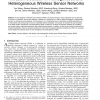Free Online Productivity Tools
i2Speak
i2Symbol
i2OCR
iTex2Img
iWeb2Print
iWeb2Shot
i2Type
iPdf2Split
iPdf2Merge
i2Bopomofo
i2Arabic
i2Style
i2Image
i2PDF
iLatex2Rtf
Sci2ools
TMC
2008
2008
Intrusion Detection in Homogeneous and Heterogeneous Wireless Sensor Networks
Intrusion detection in Wireless Sensor Network (WSN) is of practical interest in many applications such as detecting an intruder in a battlefield. The intrusion detection is defined as a mechanism for a WSN to detect the existence of inappropriate, incorrect, or anomalous moving attackers. For this purpose, it is a fundamental issue to characterize the WSN parameters such as node density and sensing range in terms of a desirable detection probability. In this paper, we consider this issue according to two WSN models: homogeneous and heterogeneous WSN. Furthermore, we derive the detection probability by considering two sensing models: single-sensing detection and multiple-sensing detection. In addition, we discuss the network connectivity and broadcast reachability, which are necessary conditions to ensure the corresponding detection probability in a WSN. Our simulation results validate the analytical values for both homogeneous and heterogeneous WSNs.
| Added | 15 Dec 2010 |
| Updated | 15 Dec 2010 |
| Type | Journal |
| Year | 2008 |
| Where | TMC |
| Authors | Yun Wang, Xiaodong Wang, Bin Xie, Demin Wang, Dharma P. Agrawal |
Comments (0)

